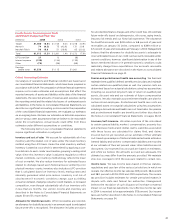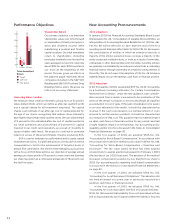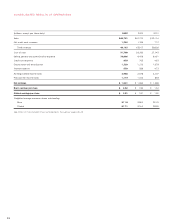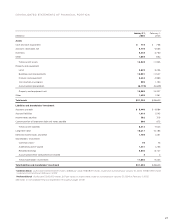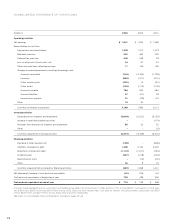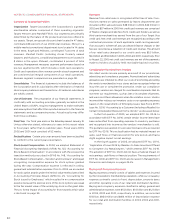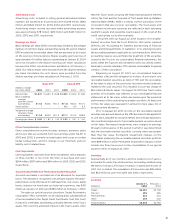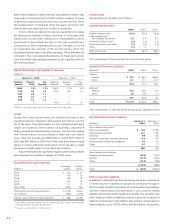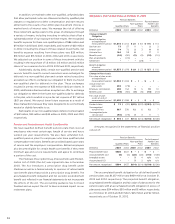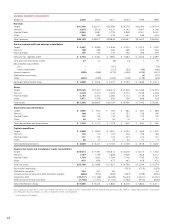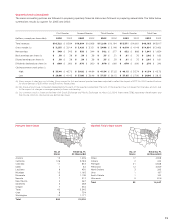Target 2003 Annual Report Download - page 32
Download and view the complete annual report
Please find page 32 of the 2003 Target annual report below. You can navigate through the pages in the report by either clicking on the pages listed below, or by using the keyword search tool below to find specific information within the annual report.
30
NOTES TO CONSOLIDATED FINANCIAL STATEMENTS
Summary of Accounting Policies
Organization Target Corporation (the Corporation) is a general
merchandise retailer, comprised of three operating segments:
Target, Mervyn’s and Marshall Field’s. Our segments are primarily
determined by the nature of the products and services offered to
our guests. Target, an upscale discount chain located in 47 states,
contributed 86 percent of our 2003 total revenues. Mervyn’s, a
middle-market promotional department store located in 14 states
in the West, South and Midwest, contributed 7 percent of total
revenues. Marshall Field’s (including stores formerly named
Dayton’s and Hudson’s), a traditional department store located in
8 states in the upper Midwest, contributed 5 percent of total
revenues. Management measures segment performance based on
pre-tax segment profit, which includes credit card operations.
Credit card operations drive revenue growth at each segment and
are considered an integral component of our retail operations.
Business segment comparisons are presented on page 38.
Consolidation The financial statements include the balances of
the Corporation and its subsidiaries after elimination of material
intercompany balances and transactions. All material subsidiaries
are wholly owned.
Use of Estimates The preparation of our financial statements, in
conformity with accounting principles generally accepted in the
United States (GAAP), requires management to make estimates
and assumptions that affect the reported amounts in the financial
statements and accompanying notes. Actual results may differ
from those estimates.
Fiscal Year Our fiscal year ends on the Saturday nearest January 31.
Unless otherwise stated, references to years in this report relate
to fiscal years rather than to calendar years. Fiscal years 2003,
2002 and 2001 each consisted of 52 weeks.
Reclassifications Certain prior year amounts have been reclassified
to conform to the current year presentation.
Stock-based Compensation In 2003, we adopted Statement of
Financial Accounting Standards (SFAS) No. 123, “Accounting for
Stock-Based Compensation,” in accordance with the prospective
transition method prescribed in SFAS No. 148, “Accounting for
Stock-Based Compensation—Transition and Disclosure” and began
recognizing compensation expense for stock options granted
during the year. Compensation expense is reflected in selling,
general and administrative expenses. Prior to 2003, we accounted
for stock option awards under the intrinsic value method prescribed
in Accounting Principles Board (APB) No. 25, “Accounting for
Stock Issued to Employees” which resulted in no compensation
expense because the exercise price of the stock options was equal
to the fair market value of the underlying stock on the grant date.
The pro forma impact of accounting for those awards at fair value
is disclosed on page 35.
Revenues
Revenue from retail sales is recognized at the time of sale. Com-
missions earned on sales generated by leased departments are
included within sales and were $38 million in 2003, $33 million in
2002 and $37 million in 2001. Net credit card revenues are comprised
of finance charges and late fees from credit card holders, as well as
third-party merchant fees earned from the use of our Target Visa
credit card. Net credit card revenues are recognized according to the
contractual provisions of each applicable credit card agreement.
If an account is written-off, any uncollected finance charges or late
fees are recorded as a reduction of credit card revenue. The amount
of our retail sales charged to our credit cards was $5.3 billion,
$5.4 billion and $5.6 billion in 2003, 2002 and 2001, respectively. Prior
to August 22, 2001, net credit card revenues are net of the payments
made to holders of publicly held receivable-backed securities.
Consideration Received from Vendors
We collect vendor income primarily as a result of our promotional,
advertising and compliance programs. Promotional and advertising
allowances are intended to offset our costs of promoting and selling
the vendor’s merchandise in our stores and are recognized when we
incur the cost or complete the promotion. Under our compliance
programs, vendors are charged for merchandise shipments that do
not meet our requirements, such as late or incomplete shipments,
and we record these allowances when the violation occurs. Vendor
income either reduces our inventory costs or our operating expenses
based on the requirements of Emerging Issues Task Force (EITF)
Issue No. 02-16, “Accounting by a Customer (Including a Reseller) for
Certain Consideration Received from a Vendor” as discussed below.
In the first quarter of 2003, we adopted EITF No. 02-16. In
accordance with EITF No. 02-16, certain vendor income items have
been reclassified from operating expenses to inventory purchases
and recognized into income as the vendors’ merchandise is sold.
The guidance was applied on a prospective basis only as required
by EITF No. 02-16. This reclassification had no material impact on
sales, cash flows or financial position for any period, and had a
slight negative impact on net earnings.
In the fourth quarter of 2003, we adopted EITF No. 03-10,
“Application of Issue 02-16 by Resellers to Sales Incentives Offered
to Consumers by Manufacturers,” which amends EITF No. 02-16.
The adoption of EITF No. 03-10 did not have a material impact on
net earnings, cash flows or financial position. The requirements of
EITF No. 02-16 and EITF No. 03-10 are discussed in Management’s
Discussion and Analysis on pages 24-25.
Buying and Occupancy Expenses
Buying expenses primarily consist of salaries and expenses incurred
by the Corporation’s merchandising operations, while our occupancy
expenses primarily consist of rent, depreciation, property taxes
and other operating costs of our retail and distribution facilities.
Buying and occupancy expenses classified in selling, general and
administrative expenses were $1.5 billion, $1.4 billion and $1.2 billion
in 2003, 2002 and 2001, respectively. In addition, we recorded
$1 billion, $934 million and $814 million of depreciation expense
for our retail and distribution facilities in 2003, 2002 and 2001,
respectively.



